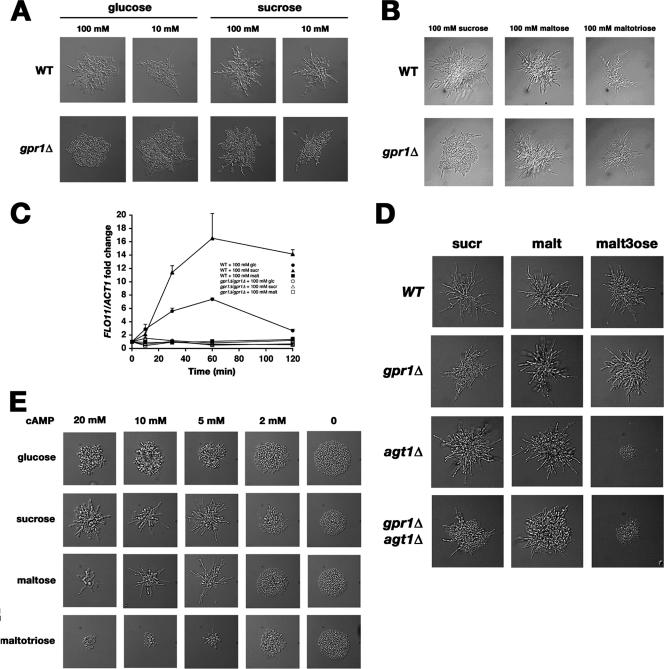FIG. 1.
Induction of pseudohyphal growth by alpha-glucoside sugars under nitrogen limitation conditions. (A) Sucrose is a more potent inducer of pseudohyphal growth than glucose at both high (100 mM) and low (10 mM) concentrations, and the effects of both sugars are dependent on Gpr1. WT, wild type. (B) Maltose and maltotriose have potencies similar to that of sucrose for induction of pseudohyphal growth, but their effects are independent of Gpr1. (C) Addition of glucose and sucrose, but not maltose, to derepressed cells causes rapid induction of FLO11 in a Gpr1-dependent manner. The relative expression of FLO11 was measured over a 2-hour interval after sugar addition by real-time quantitative PCR analysis. A diploid wild-type strain and a gpr1Δ/gpr1Δ mutant were grown overnight to mid-exponential phase (optical density at 600 nm, 2 to 4) on 2% glycerol. The error bars indicate standard deviations. (D) Induction of pseudohyphal growth by maltotriose, but not by sucrose or maltose, is deficient in a strain lacking the Agt1 (Mal11) transporter. Cells were grown for 24 h on nitrogen-limiting (SLA) medium supplemented with the indicated sugars. sucr, sucrose; malt, maltose; malt3ose, maltotriose. (E) A minimum level of cAMP is required for induction by alpha-glucoside sugars. A homozygous cyr1Δ yak1Δ pde2Δ mutant was grown on nitrogen-limiting medium (SLA) supplemented with 100 mM glucose, sucrose, maltose, or maltotriose. Intracellular cAMP concentrations were controlled by the addition of cAMP to the growth medium in the indicated concentrations. Pseudohyphal growth under these conditions was induced with external cAMP concentrations of 2 mM and higher. At all cAMP concentrations, sucrose and maltose were more potent inducers than glucose. Growth on maltotriose was reduced with increasing cAMP concentrations, and filamentation was limited.

